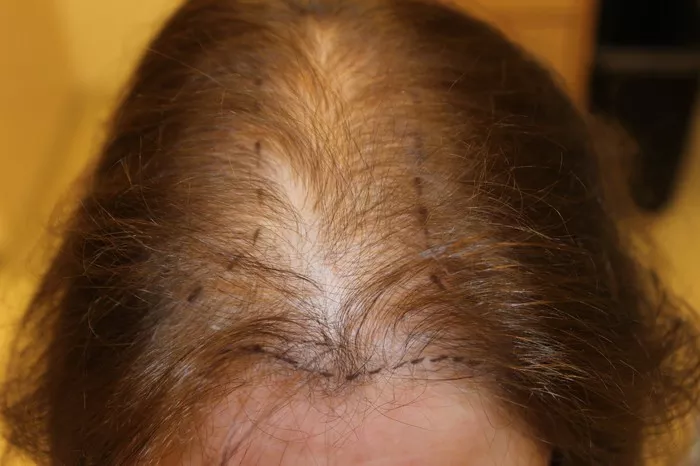Hair loss is a common concern that affects millions of individuals worldwide. Androgenic alopecia, often referred to as male-pattern baldness or female-pattern baldness, is one of the primary culprits behind hair thinning and loss. Understanding the triggers of androgenic alopecia is crucial for those seeking to manage or prevent this condition. In this comprehensive article, we will delve into the various factors that trigger androgenic alopecia, shedding light on the intricate mechanisms behind this widespread issue.
Genetic Predisposition: The Primary Catalyst
Genetics play a pivotal role in the development of androgenic alopecia. If there is a family history of baldness or thinning hair, individuals are more likely to inherit the genetic predisposition for this condition. The hereditary link is associated with the presence of specific genes that influence the hair follicles’ sensitivity to dihydrotestosterone (DHT), a hormone derived from testosterone.
Hormonal Imbalance: DHT Takes Center Stage
Androgenic alopecia is closely linked to the hormone DHT, a derivative of testosterone. In individuals genetically predisposed to androgenic alopecia, hair follicles in certain areas of the scalp are sensitive to DHT. When DHT binds to receptors in the hair follicles, it triggers a process known as miniaturization. This process causes the affected hair follicles to shrink over time, leading to thinner and shorter hair strands. Eventually, the affected follicles may stop producing new hair altogether, resulting in noticeable hair loss.
Age-Related Changes: A Natural Evolution
As individuals age, hormonal fluctuations become more pronounced. Androgenic alopecia tends to become more prevalent with age, and the severity of hair loss often increases over time. While age-related changes affect both men and women, the patterns of hair loss can differ between the sexes. Men typically experience a receding hairline and balding at the crown, while women may notice overall thinning across the top of the scalp.
Medical Conditions and Medications: Contributing Factors
Certain medical conditions and medications can contribute to the onset or exacerbation of androgenic alopecia. Conditions such as polycystic ovary syndrome (PCOS) and thyroid disorders can disrupt hormonal balance and contribute to hair loss. Additionally, medications such as anabolic steroids, certain contraceptives, and anticoagulants may have hair-thinning side effects, further complicating the picture for individuals already genetically predisposed to androgenic alopecia.
Lifestyle Factors: Stress and Poor Nutrition
Stress and poor nutrition can also act as triggers for androgenic alopecia. Chronic stress can lead to hormonal imbalances, including an increase in cortisol levels, which may contribute to hair loss. Furthermore, a diet lacking in essential nutrients, such as iron, zinc, and vitamins, can negatively impact hair health and contribute to the progression of androgenic alopecia.
Traction Alopecia: Hairstyles and Haircare Practices
While androgenic alopecia is primarily genetic, certain external factors can exacerbate hair loss. Traction alopecia is a form of hair loss caused by excessive tension on the hair, often due to tight hairstyles or haircare practices. Pulling the hair into tight ponytails, braids, or using hot styling tools excessively can contribute to hair thinning and breakage. Although traction alopecia is different from androgenic alopecia, it can compound the overall impact of hair loss.
Environmental Factors: Pollution and UV Exposure
Environmental factors, such as exposure to pollution and ultraviolet (UV) radiation, can also play a role in triggering androgenic alopecia. Pollutants in the air may contribute to inflammation and oxidative stress, affecting the health of the scalp and hair follicles. UV exposure can lead to damage to the hair shaft and may contribute to increased hair loss in individuals with a genetic predisposition to androgenic alopecia.
Prevention and Management: Taking Control of Your Hair Health
While the genetic component of androgenic alopecia may be inevitable, there are steps individuals can take to manage and potentially slow down the progression of hair loss. Lifestyle modifications, stress management techniques, and a well-balanced diet rich in essential nutrients can positively impact overall hair health. Additionally, consulting with a healthcare professional or a dermatologist can provide personalized guidance on available treatments, such as topical medications or oral medications, to address androgenic alopecia.
See Also: Can Low Red Blood Cells Cause Hair Loss: What You Need To Know
In conclusion
Understanding the triggers of androgenic alopecia is the first step toward effective management and prevention. By recognizing the interplay of genetic, hormonal, environmental, and lifestyle factors, individuals can take proactive measures to maintain optimal hair health. Whether through lifestyle modifications, medical interventions, or a combination of both, taking control of one’s hair health empowers individuals to navigate the complexities of androgenic alopecia with confidence.


